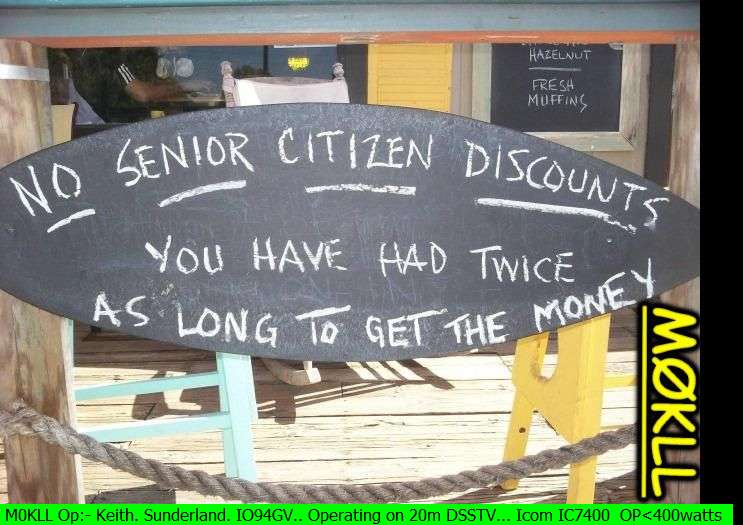
<EOT>
www.rhci-online.net/radiogram/radiogram.htm
██╗ ██╗██████╗ ██████╗ ██████╗ █████╗ ██████╗ ██╗ ██████╗ ██████╗ ██████╗ █████╗ ███╗ ███╗ ██║ ██╔╝██╔══██╗██╔════╝ ██╔══██╗██╔══██╗██╔══██╗██║██╔═══██╗██╔════╝ ██╔══██╗██╔══██╗████╗ ████║ █████╔╝ ██████╔╝██║ ██████╔╝███████║██║ ██║██║██║ ██║██║ ███╗██████╔╝███████║██╔████╔██║ ██╔═██╗ ██╔══██╗██║ ██╔══██╗██╔══██║██║ ██║██║██║ ██║██║ ██║██╔══██╗██╔══██║██║╚██╔╝██║ ██║ ██╗██████╔╝╚██████╗ ██║ ██║██║ ██║██████╔╝██║╚██████╔╝╚██████╔╝██║ ██║██║ ██║██║ ╚═╝ ██║ ╚═╝ ╚═╝╚═════╝ ╚═════╝ ╚═╝ ╚═╝╚═╝ ╚═╝╚═════╝ ╚═╝ ╚═════╝ ╚═════╝ ╚═╝ ╚═╝╚═╝ ╚═╝╚═╝ ╚═╝
|
RSID: <<2014-07-26T11:32Z
MFSK-64 @ 6095000+1500>>
<STX>
Geir Laastad in Norway listens to The Mighty KBC from his cabin
in Telemark, Norway -- "totally free from local man-made QRM."
<EOT>
<STX>
Sending Pic:88x184C;

<EOT>
<STX>
http://www.kbcradio.eu/index.php?dir=gallery
<EOT>
██╗ ██╗ ██████╗ █████╗ ██████╗ █████╗ ██████╗ ██╗ ██████╗ ██████╗ ██████╗ █████╗ ███╗ ███╗ ██║ ██║██╔═══██╗██╔══██╗ ██╔══██╗██╔══██╗██╔══██╗██║██╔═══██╗██╔════╝ ██╔══██╗██╔══██╗████╗ ████║ ██║ ██║██║ ██║███████║ ██████╔╝███████║██║ ██║██║██║ ██║██║ ███╗██████╔╝███████║██╔████╔██║ ╚██╗ ██╔╝██║ ██║██╔══██║ ██╔══██╗██╔══██║██║ ██║██║██║ ██║██║ ██║██╔══██╗██╔══██║██║╚██╔╝██║ ╚████╔╝ ╚██████╔╝██║ ██║ ██║ ██║██║ ██║██████╔╝██║╚██████╔╝╚██████╔╝██║ ██║██║ ██║██║ ╚═╝ ██║ ╚═══╝ ╚═════╝ ╚═╝ ╚═╝ ╚═╝ ╚═╝╚═╝ ╚═╝╚═════╝ ╚═╝ ╚═════╝ ╚═════╝ ╚═╝ ╚═╝╚═╝ ╚═╝╚═╝ ╚═╝
RSID: <<2014-07-26T16:02Z
MFSK-32 @ 17860000+1500>>
<STX>
Welcome to program 69 of VOA Radiogram from the Voice of America.
I'm Kim Andrew Elliott in Washington.
Here is the lineup for today's program (MFSK32):
1:38 Program preview (now)
2:32 Voice of Russia in Washington, with image
6:14 Iranian satellite jamming, with image
10:47 Battery of the future, with image
18:29 VOA Russian on global Internet policy, with image
25:10 Closing announcements
Please send reception reports to radiogram@voanews.com.
And visit voaradiogram.net.
Twitter: @VOARadiogram
<EOT>
<STX>
Voice of Russia Shuts DC Bureau
VOA News
July 15, 2014
Facing legal problems, the Russian government-funded radio
network — the Voice of Russia — has fired its Washington bureau
staff and closed the office.
The shutdown happened July 14, amid allegations of tax fraud and
claims of racial discrimination at the network.
Alexei Iazlovsky, the head of the VOR's U.S. operations, pleaded
guilty last year to tax fraud and will be sentenced later this
year.
VOR's employment practices also have attracted attention from the
IRS and the Equal Employment Opportunity Commission.
The IRS is investigating whether VOR used contractors alongside
full-time, salaried employees to skirt payroll taxes. The Equal
Employment Opportunity Commission took an interest in VOR after
several former staffers claimed they were fired because of their
race.
The employees have filed a lawsuit against International TV
Services, VOR's contract manager in the United States.
Some suspect Voice of Russia will quickly return to the U.S.
through a different management company without the legal
troubles.
Earlier this year, the Russians stopped Voice of America
broadcasting in Moscow on AM radio.
http://www.voanews.com/content/voice-of-russia-shuts-dc-bureau/1958378.html
Note from Kim: The Voice of Russia is the former Radio Moscow,
which broadcast in more languages, from more transmitters, than
any international radio station of the Cold War era. Voice of
Russia is still available in the Washington area, 24 hours a day,
leasing time on WZHF, 1390 kHz AM. With the VOR Washington studio
closed, all Voice of Russia programs now originate in Moscow. The
station usually identifies itself as "Radio VR."
<EOT>
<STX>
Sending Pic:328x50C;

<EOT>
<STX>
This is VOA Radiogram from the Voice of America.
Please send reception reports to radiogram@voanews.com.
From Radio Free Europe/Radio Liberty:
Iranian Satellite Jamming Causes Storm Of Controversy
By Frud Bezhan
July 23, 2014
The Iranian regime has long used signal jamming to disrupt the
flow of information into the Islamic republic, but it couldn't
have forecast the strategy's deadly consequences.
Satellite-jamming technology is being blamed for disrupting
Iran's ability to predict a major dust storm that hit Tehran in
June, killing five people.
In a report presented to parliament this week, the Iran
Meteorological Organization claimed it was unable to forecast the
massive dust storm because of signals emitted by jamming devices,
according to the semiofficial ISNA news agency on July 22.
In addition to the five killed, the June 2 storm injured several
dozen people and knocked out power to around 50,000 homes in the
capital, according to Iranian media reports.
ISNA quoted Iran Meteorological Organization official Ahad
Vazifeh as saying that pertinent authorities had been warned of
the effect of jamming signals on meteorology forecasts before the
deadly storm hit Tehran.
Iran has been known to use jamming technology to prevent
satellite transmissions of foreign-based television and radio
channels.
The government seems to intensify its jamming efforts during
sensitive times, such as the widespread protests that followed
Iran's 2009 presidential election, and the Arab Spring
revolutions.
Iranian officials have acknowledged that signal jamming takes
place, and have even warned of potentially negative consequences,
including health dangers posed by signal jamming.
In February, the Iranian Health Ministry set up a committee to
investigate whether the government's jamming of satellite signals
could pose a health risk to citizens.
http://www.rferl.org/content/iran-jamming-controversy-storm/25467735.html
<EOT>
<STX>
Sending Pic:288x92C;

<EOT>
<STX>
This is VOA Radiogram from the Voice of America.
Please send reception reports to radiogram@voanews.com.
VOA NEWS
Chicago's Argonne Lab Developing Battery of the Future
Kane Farabaugh
July 20, 2014
CHICAGO - In 2012, the Department of Energy's Office of Science
awarded a $120 million grant to a new technology center focused
on battery development - headquartered at Argonne National
Laboratory in suburban Chicago, Illinois. The Joint Center for
Energy Storage Research brings together scientists and engineers
from government, national laboratories, and industry to provide
them with the tools, funding, and space to make the next
technological breakthrough in energy storage.
Smaller. Lighter. Longer Lasting. That's what consumers want in
the batteries they use to power personal electronics.
At the Joint Center for Energy Storage Research, or J-CESR,
researchers hope to meet the demand.
This is the birthplace of the lithium ion battery technology, but
J-CESR scientists and engineers have bigger - and smaller - goals
in mind.
"Five times the energy density at one fifth the cost." And all
this is five years, accrdoing to deputy director Jeffrey
Chamberlain. Cell phones, he says, are the devices where
consumers will first notice a change.
"So instead of charging it every day, they might be able to
charge it every few days or every week. Or instead of having
certain power and capability, they might be able to get to a kind
of power that might be unimagined," says he.
Chamberlain says the ultimate goal is to change the worldwide
automotive market.
"The bigger mission we are on is trying to store energy in a way
that is cost-effective and safe so that we can compete directly
with the internal combustion engine using electricity or electric
transport," says Chamberlain.
Argonne's Energy Systems Division Director Don Hillebrand says
more power for personal electronics is an easy sell - but
consumers demand change when it comes to cars.
"Some consumers want an all-electric vehicle. The big debate
right now is how many of them are there? That number changes
based on how much gasoline costs. Really at what point does
gasoline get expensive enough that it drives more people into
wanting all-electrics?" – asks Hillebrand.
Hillebrand says the sales figures this year - about ten thousand
electric vehicles sold per month in the United States - is below
industry expectations, but the battery the center is developing
could change the picture.
"It's showing steady growth as we go forward. That number needs
to be ten times bigger for us to really say that this program has
been a success, and getting to that ten times is really tied to
getting the battery to what we need it to be," says Hillebrand.
But if that battery development is successful, and sales of
electric powered vehicles take off, there will be increased
demand on the existing power grid to recharge those batteries - a
problem the scientists and researchers at J-CESR are also
tackling by developing a large scale battery for the grid.
http://www.voanews.com/content/chicago-argonne-lab-developing-battery-of-the-future/1961622.html
<EOT>
<STX>
Image: Screenshot from the video version of this VOA News story...
<EOT>
<STX>
Sending Pic:270x188C;

<EOT>
RSID: <<2014-07-26T16:18Z
MFSK-32 @ 17860000+1500>>
<STX>
|
From VOA Russian/От VOA «Голос Америки»:
|
Von
VOA Russisch /
von
VOA "Stimme Amerikas":
des Internets
beschäftigt haben: Wer und wie sollte
das globale Netzwerk
reguliert werden?.
und die Teilnahme an der Entwicklung des Internets sich für alle Beteiligten dieses Kommunikationsprozesses als ein Weg erweist, um das globale Netz
weiter zu
entwickeln "- setzte Strickling fort..
[meine Russisch-Kenntnisse sind schon etwas "eingerostet".... Übersetzung "unter Vorbehalt".... roger :-] |
<EOT>
<STX>
Sending Pic:301x42C;
![]()
<EOT>
<STX>
Please send reception reports to radiogram@voanews.com.
And visit voaradiogram.net.
Twitter: @VOARadiogram
Thanks to colleagues at the Edward R. Murrow shortwave
transmitting station in North Carolina.
I'm Kim Elliott. Please join us for the next VOA Radiogram
This is VOA, the Voice of America.
<EOT>
RSID: <<2014-07-26T16:26Z MFSK-64
@ 17860000+1500>>
<STX>
Sending Pic:632x56C;

<EOT>
RSID: <<2014-07-26T16:28Z
Olivia-64-2K @ 17860000+1500>>
Thank you for decoding the modes on VOA Radiogram.
www.rhci-online.net/radiogram/radiogram.htm
|
QTH: |
D-06193 Petersberg (Germany/Germania) |
|
Ant.: |
Dipol for 40m-Band |
|
RX: |
ICOM IC-R75 + IF-mixer |
|
Software IF: |
con STUDIO1 - Software italiano per SDR [SAM-USB] |
|
Software AF: |
|
|
OS: |
German XP-SP3 with support for asian languages |
|
PC: |
MEDION Titanium 8008 (since 2003) [ P4 - 2,6 GHz] |
DRM-image - received via EASYPAL/DSSTV on 14233kHz/USB (FRG-100 / Dipol for ~12 MHz)
Here are some pictures of MØKLL (Keith, from Sunderland/UK) received in the last weeks:
|
|
||
|
|
 |
|
|
|
 |
|
|
|
 |
|
|
|
 |
|
|
|
 |
|
|
|
 |
|
|
|
||
|
|
 |
 |
|
|
 |
|
|
|
 |
|
|
|
||
|
|
 |
|
|
|
 |
|
|
|
 |
|
 |
||